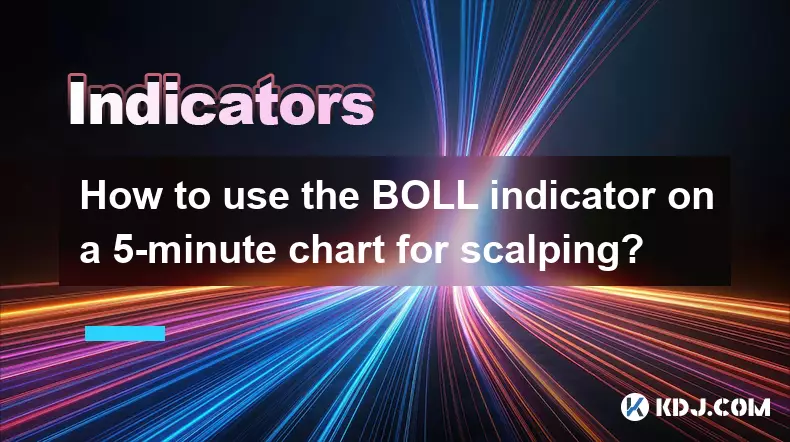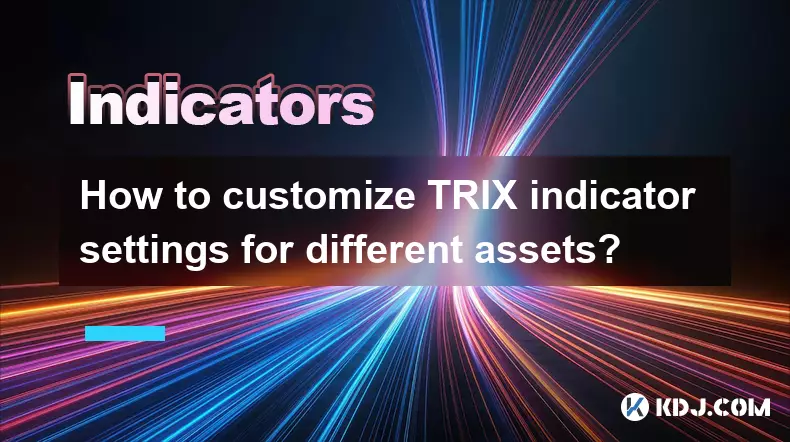-
 bitcoin
bitcoin $100977.009184 USD
-2.05% -
 ethereum
ethereum $3282.009150 USD
-3.23% -
 tether
tether $0.999813 USD
-0.02% -
 xrp
xrp $2.208254 USD
-4.89% -
 bnb
bnb $951.411089 USD
0.55% -
 solana
solana $155.761205 USD
-2.84% -
 usd-coin
usd-coin $1.000217 USD
0.02% -
 tron
tron $0.284475 USD
-1.28% -
 dogecoin
dogecoin $0.162363 USD
-1.53% -
 cardano
cardano $0.533988 USD
-0.47% -
 hyperliquid
hyperliquid $39.174339 USD
-3.22% -
 chainlink
chainlink $14.724828 USD
-1.16% -
 bitcoin-cash
bitcoin-cash $477.297986 USD
-1.28% -
 zcash
zcash $554.227426 USD
17.30% -
 ethena-usde
ethena-usde $0.998995 USD
-0.03%
How to use the BOLL indicator on a 5-minute chart for scalping?
The BOLL indicator helps scalpers identify volatility, trend direction, and breakout opportunities on 5-minute charts, especially when combined with volume and RSI for high-probability entries.
Nov 07, 2025 at 07:19 pm

Understanding the BOLL Indicator in Scalping
1. The Bollinger Bands (BOLL) indicator consists of three lines: the middle band, typically a 20-period simple moving average, and upper and lower bands that represent standard deviations from the mean. These bands dynamically expand and contract based on market volatility, making them highly responsive on short timeframes like the 5-minute chart.
2. In scalping, traders aim to capture small price movements within minutes, often entering and exiting positions rapidly. The BOLL indicator helps identify overbought or oversold conditions when price touches or breaches the upper or lower bands. This can signal potential reversal points ideal for quick entries and exits.
3. When price consistently hugs the upper band, it suggests strong bullish momentum, while prolonged contact with the lower band indicates bearish control. These tendencies help scalpers align their trades with short-term trends.
4. A key feature of BOLL is the “squeeze,” which occurs when the bands narrow significantly. This reflects low volatility and often precedes sharp price breakouts. Scalpers watch for this pattern closely, preparing to enter as soon as price moves decisively beyond one of the bands with confirming volume.
Setting Up BOLL for 5-Minute Scalping
1. Apply the BOLL indicator to your 5-minute chart with default settings: 20 periods and 2 standard deviations. While some traders adjust these values, the standard configuration works well due to its balance between responsiveness and reliability.
2. Overlay a volume indicator to confirm breakout signals. High volume during a band breach increases the likelihood of a sustainable move, reducing false signals common in fast-paced environments.
3. Combine BOLL with a momentum oscillator such as the RSI (14-period) set to a 5-minute timeframe. When price touches the lower band and RSI shows oversold conditions below 30, it strengthens a long scalp setup. Conversely, upper band touch with RSI above 70 supports a short entry.
4. Use horizontal support and resistance levels alongside BOLL. A touch of the lower band near a known support level increases the probability of a bounce, offering a favorable risk-reward entry point for a long scalp.
Executing Scalp Trades Using BOLL Signals
1. Look for price to touch or slightly penetrate the upper or lower band. Do not initiate a trade immediately—wait for a candlestick close beyond the band or a reversal pattern like a pin bar or engulfing candle to confirm the move.
2. Enter long when price bounces off the lower band with increasing volume and bullish candlestick confirmation. Place a tight stop-loss just below the recent swing low or beneath the lower band to limit downside risk.
3. Enter short when price rejects the upper band with strong bearish momentum and closing candles below the band. Set stop-loss above the latest swing high or upper band to protect against sudden reversals.
4. Target partial profit at the middle band (20 SMA), which often acts as dynamic resistance or support. Close the remainder if price shows hesitation or reaches the opposite band, adjusting based on real-time momentum.
5. Avoid trading during low-volume periods such as major holidays or the end of trading sessions. BOLL signals become less reliable when market participation drops, leading to choppy price action and increased slippage.
Frequently Asked Questions
What does a BOLL squeeze indicate for a 5-minute scalper?A BOLL squeeze indicates contracting volatility, where the upper and lower bands come close together. For scalpers, this often precedes a sharp directional move. Once price breaks through one of the bands with strong volume, it presents a high-probability entry opportunity in the direction of the breakout.
Can BOLL be used alone for scalping decisions?While BOLL provides valuable insights into volatility and potential reversal zones, relying on it alone increases the risk of false signals. Combining it with volume analysis, candlestick patterns, and a secondary momentum indicator improves accuracy and helps filter out noise inherent in 5-minute charts.
How should stop-loss be managed when using BOLL on a 5-minute chart?Stop-loss orders should be placed just beyond the outer bands or recent price extremes. For long setups, place the stop below the lower band; for short setups, above the upper band. Adjust based on recent volatility—wider stops may be needed during high-impact news events.
Is the default 20,2 setting optimal for all assets?The default 20-period SMA with 2 standard deviations works effectively across most liquid crypto pairs. However, some traders fine-tune the settings based on specific asset volatility. For example, highly volatile altcoins might benefit from a slight adjustment to 18,2.1 to increase sensitivity without sacrificing signal quality.
Disclaimer:info@kdj.com
The information provided is not trading advice. kdj.com does not assume any responsibility for any investments made based on the information provided in this article. Cryptocurrencies are highly volatile and it is highly recommended that you invest with caution after thorough research!
If you believe that the content used on this website infringes your copyright, please contact us immediately (info@kdj.com) and we will delete it promptly.
- BlockDAG, Avalanche, Dogecoin: Crypto's Leading Trio in 2025
- 2025-11-07 22:05:01
- Layer 2 Coins: Will There Be a Potential Explosion by 2026?
- 2025-11-07 16:50:02
- Filecoin, ICP, and the AI Infrastructure Renaissance: Is History Repeating?
- 2025-11-07 16:50:02
- Bitcoin's Wild Ride: Surges, Zeros, and the Search for Stability
- 2025-11-07 17:05:01
- XRP, Bitcoin, and the Rally: What's the Deal, New York?
- 2025-11-07 17:25:01
- Filecoin, DePIN, and a Technical Breakout: What's the Buzz?
- 2025-11-07 17:05:01
Related knowledge

How do professional traders use the TRIX indicator?
Nov 06,2025 at 04:40pm
Understanding the TRIX Indicator in Crypto TradingThe TRIX (Triple Exponential Average) indicator is a momentum oscillator used by professional trader...

Can I use the TRIX indicator on my mobile trading app?
Nov 07,2025 at 07:40pm
The TRIX indicator, a momentum oscillator designed to filter out short-term fluctuations and highlight long-term trends, has become increasingly popul...

How to code a simple TRIX indicator script in Pine Script?
Nov 07,2025 at 06:20am
How to Code a Simple TRIX Indicator in Pine Script The TRIX (Triple Exponential Moving Average) indicator is widely used in cryptocurrency trading to ...

How to trade TRIX indicator signals on the 1-hour chart?
Nov 07,2025 at 05:39am
Bitcoin's Role in Decentralized Finance1. Bitcoin remains the cornerstone of decentralized finance, serving as a benchmark for value and security acro...

Can the TRIX indicator be used for long-term investing?
Nov 06,2025 at 02:19pm
Understanding the TRIX Indicator in Cryptocurrency Markets1. The TRIX (Triple Exponential Average) indicator is a momentum oscillator designed to filt...

How to customize TRIX indicator settings for different assets?
Nov 06,2025 at 03:39pm
Understanding the TRIX Indicator in Cryptocurrency Trading1. The TRIX (Triple Exponential Average) indicator is a momentum oscillator designed to filt...

How do professional traders use the TRIX indicator?
Nov 06,2025 at 04:40pm
Understanding the TRIX Indicator in Crypto TradingThe TRIX (Triple Exponential Average) indicator is a momentum oscillator used by professional trader...

Can I use the TRIX indicator on my mobile trading app?
Nov 07,2025 at 07:40pm
The TRIX indicator, a momentum oscillator designed to filter out short-term fluctuations and highlight long-term trends, has become increasingly popul...

How to code a simple TRIX indicator script in Pine Script?
Nov 07,2025 at 06:20am
How to Code a Simple TRIX Indicator in Pine Script The TRIX (Triple Exponential Moving Average) indicator is widely used in cryptocurrency trading to ...

How to trade TRIX indicator signals on the 1-hour chart?
Nov 07,2025 at 05:39am
Bitcoin's Role in Decentralized Finance1. Bitcoin remains the cornerstone of decentralized finance, serving as a benchmark for value and security acro...

Can the TRIX indicator be used for long-term investing?
Nov 06,2025 at 02:19pm
Understanding the TRIX Indicator in Cryptocurrency Markets1. The TRIX (Triple Exponential Average) indicator is a momentum oscillator designed to filt...

How to customize TRIX indicator settings for different assets?
Nov 06,2025 at 03:39pm
Understanding the TRIX Indicator in Cryptocurrency Trading1. The TRIX (Triple Exponential Average) indicator is a momentum oscillator designed to filt...
See all articles





















![The Graph Price Prediction [GRT Crypto Price News Today] The Graph Price Prediction [GRT Crypto Price News Today]](/uploads/2025/11/07/cryptocurrencies-news/videos/690d4df44fe69_image_500_375.webp)




















































